We use cookies to deliver you the best experience. By browsing our website you agree to our use of cookies. Learn More
Product Showcase
-
Ergon Grips are Ergonomically Correct!

Want to be more comfortable on your bike?
Invest in your points of contact; saddle, GRIPS and pedals. You will bike farther, have more fun, and be in less pain at the end of the day. Ergonomics is at the core of Ergon. Their products are all about understanding how people engage with their bikes.
Ergon introduced their original winged grip in 2004, helping to eliminate numb hands, aching fingers and tired forearms. Now they have a wide variety of grips designed specifically around a particular riding style, handlebar and rider position. The grips are compatible with almost any bicycle, from downhill and touring, to xc racing and folding commuters. Most of the grips are available in two sizes, small and large, with options to mate perfectly with your bike.
Sometimes too many choices can be overwhelming, so if you have questions about what might be right for you, don’t hesitate to call, or even better, come on down and check them out in person and on a bike.
Basically if your handlebars are swept back, the GC1's are going to be what you're after and straight bars have a wide world of choices.All the materials Ergon uses are tested for toxicity and meet the highest German government safety standards. Their products go through extensive deterioration and life-span tests, including a 4 year environmental exposure simulation, as well as abuse from the some of the world’s top athletes and are backed with a 2 year warranty.
-
Leather Saddle Care
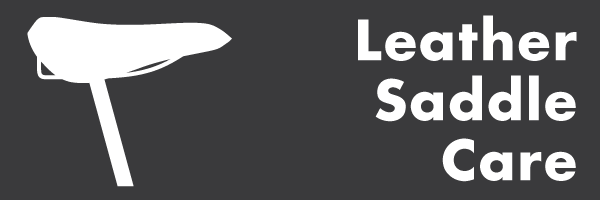
Last month, we covered a variety of ways to protect a leather saddle from rain. Through the course of researching for that article, we came across many other articles and forum posts on leather saddles. The overall landscape of information out there is disheartening. There is a lot of confusion, fear, and mystical speculation around the subject. Apparently us children of post-industrial economics have trouble thinking about natural materials, and tend to relegate them to the same bin as things like weather prediction, the Tarot, and alchemical processes. But it’s really not that complicated. Yes, you can ruin a leather saddle. You can also ruin anything else if you start poking at it without any guidance. So we’ve harvested a small heap of saddle wisdom for you to get you started.
There are a handful of manufacturers making leather saddles in 2015, some surviving since the dawn of cycling, others started on Kickstarter in the past few years. The pattern is somewhat similar to that of preserved foods, anything made of waxed canvas, hipster hatchets, and wool athletic clothing. The hype of plastic is burnt out, and we are realizing that sometimes the most technically advantageous material happens to already grow on the back of some living creature, or a tree. Our favorite manufacturer is Brooks, who have been making their saddles for a very long time indeed and, thanks to their wide distribution and eternal status, produce a multitude of shapes, sizes, and colors (and special editions, and unique editions, etc, etc…). But how to pick?! Well, we can’t help you decide which shade of brown will suit your frame color best*, nor can we tell you which saddle will fit you! Only your own body can guide you, and it usually turns out, if we may borrow the old wizarding adage, that “the wand chooses the wizard.” Stop by your LBS with the hugest selection of Brooks saddles (big hint if you live in Minnesota) and test out some saddles. Start with something appropriate for your general riding style: narrower for leaned-in drop bar riders, wider for the laid-back cruiser. Put it on a chair and take a seat, and try a few! Brooks saddles are gendered (“S” for women’s fit). It’s a little old fashioned, don’t feel weird if you feel better on the “other” type, many do! We’ll help you out if you are confused, disparaged, or lost.

So you've found a saddle. Now we are going to give your brand new $200 leather-and-steel throne a shove down its path of decay. But we are going to control it, hold its hand, massage it, give it compliments and play it Mozart. You could just throw it on the seat post and start chugging, feeding the leather off your own oily skin and sweat. This works for some, and I salute them. They ride enough and weigh enough to use their calloused Sitz bones as shoe hammers, carving themselves a dwelling into the stone-hard surface of Brooks leather. This is what Brooks recommends, by the way. But Brooks leather is tough, and bone dry. It is shaped with heat and baked at high temperatures until the fibers set, similar to the process used to make medieval leather armor. A new Brooks saddle is a tabula rasa, waiting for your personal "touch". It requires input to selectively soften the areas that need softening, thus:
- Acquire some Brooks Proofide.
- Load a good helping onto the middle-rear section of the seat. Think of the saddle in two parts: the nose, and the seat. You are aiming for the front portion of the seat area, where your Sitz bones land. Get some on the raw underside of the saddle in the same area. Spread a very light coat on the rest of the top surface.
- Let the Proofide soak into the leather for a bit, until dry. It soaks in surprisingly fast. Like we said, these saddles are bone dry.
- Polish off the excess with a clean polishing rag. This will unseat any dye left on the surface of the saddle that would otherwise end up on your shorts.
- Ride hard, ride often.
- The saddle should start to deform, and should be very comfortable in 100 - 200 miles.
Here's what it looked like when we treated one of our store demonstrator saddles:
After the initial break-in period, an occasional treatment with Proofide will keep the leather supple and reasonably protected from water damage, but it will not be waterproof†. Proofide is made of waxes and oils, which don't mix with water, but if enough Proofide were used to waterproof the saddle, it would become too soft and would stretch beyond usefulness. Don't do it! And a final word: should you be tempted by that nice little chrome tensioning tool stamped with the Brooks logo, don't touch it! You will have plenty of experience with your saddle before it is necessary. Now go ride your magic carpet of velo-human friendship!
* - actually we can! Stop by and we’ll give you our refined and well-informed opinion.
† - see our previous post, "Seat Thoughts: Saddle Covers".
-
Seat Thoughts: Saddle Covers
The quickest and often most economical upgrade to any bicycle is a better saddle. The most important factor in your ability to enjoy longer rides more often isn’t your bike’s weight or how many gears you have, it’s your comfort. And a good quality saddle, if taken care of, can last you decades! Of course, good quality usually (not always, but usually) means leather, and leather means taking a little more time and care, the “old fashioned" way if you will. You may hear overcautious talk of leather saddles being easily “ruined” or “hard to maintain”, but if you can handle a pair of leather boots, you will have no trouble providing for your throne, and it will in turn thank you with years of peaceful human-bike unity.
Of course, the most important consideration with leather is rain, and for that we have saddle covers! They all have their perks, otherwise we wouldn’t stock so many of them. Let’s take a look at the options, shall we?
Brooks Saddle Covers
The Brooks Rain Cover comes in two sizes: Medium and Large. The larger accommodates the wider sit-down shape of the B67, etc. B17 and others of the type fit into the “medium”. If you ride a cruiser/comfort/dutch style saddle, the large ought to do. These photos are of the “large” cover on a B67. The cover is made of a nice-quality waterproof nylon material and fits rather baggy on the saddle. It is super-easy to take on and off, thanks to the elastic band closure.
A velcro strap helps keep the cover rolled up burrito-style, and doubles as an attachment device, looping around the rails under the leather upper. Perfecto fit, and looks nice. We don’t recommend making a habit of riding on this cover, and neither does Brooks, but it’s not exactly delicate.
Carradice Saddle Cover
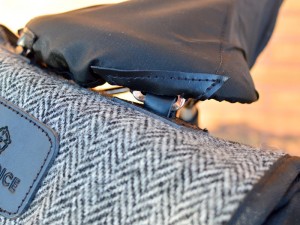
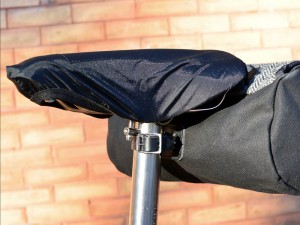
Carradice, a modest British manufacturer of very-high quality and practical cycling baggage, makes a cover specifically sized to the Brooks B17. It also fits the Flyer (B17 with springs). This cover fits rather taught, and is meant to be ridden on, making it an excellent choice for tough conditions. This cover provides leather-reinforced slots for bag loops, so a Carradice (or other) saddle bag hangs unimpeded. An excellent choice for a 3-month trek on your beloved Brooks saddle. This is the Saddle Cover that randonneurs most often choose to protect their leather saddles.
North Street Saddle Cover
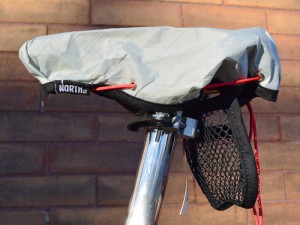 North Street Bags from Portland, Oregon, makes lovely and impressive cycle baggage. Their saddle covers are of the same durable, coated ripstop nylon that they use for their waterproof liners, and unlike most saddle covers, come in colors! North Street is part of a burgeoning movement in Made In USA gear that is equally at home amongst at the coffee shop and the mountain trail. Their saddle covers are designed to be used, and will fit just about any saddle thanks to their draw-string closure (both B17 S and B67 were covered adequately and snugly).
North Street Bags from Portland, Oregon, makes lovely and impressive cycle baggage. Their saddle covers are of the same durable, coated ripstop nylon that they use for their waterproof liners, and unlike most saddle covers, come in colors! North Street is part of a burgeoning movement in Made In USA gear that is equally at home amongst at the coffee shop and the mountain trail. Their saddle covers are designed to be used, and will fit just about any saddle thanks to their draw-string closure (both B17 S and B67 were covered adequately and snugly).Aardvark Saddle Cover
Aardvark Cycling Accessories doesn’t have a website, but they make this ultra-generic and ultra-awesome saddle cover. Made of neoprene (wetsuit material) instead of nylon, so it’s a little squishy. Waterproof, but will hold water, so remember to take it off before sitting on it after a rainstorm! It's stretchy so it fits any saddle just fine. Awesome 80’s Aardvark-on-a-mountain-bike logo indicates these folks aren’t kidding around. Made in Richmond, UT, where there are definitely more mountain bikes than aardvarks. This one is an old favorite for making an expensive saddle look not-so-expensive in thief-prone zones.
See ALL the saddle covers HERE
-
Zimbale Bike Bags 2.0
zimbale: | zimbälē | • beautifully designed, hand crafted bicycle bags
Zimbale is back after a 2 year hiatus. Perennial Cycle is happy to have Zimbale back on the shelves and on our bikes! Zimbale is a small, hard-working group from Seoul, Korea that specialize in leather and cotton canvas bike bags. Before they stopped production Perennial Cycle had been selling their product for 3 seasons. Zimbale bags were always a clean blend of function and practicality with a classic look and style. It was obvious to us that the designers of the bags were passionate about cycling.
Below is an interview with Lee, the founder of Zimbale:
1.) Who owns Zimbale Bags?
Mr. K.J.Lee, founder of Bookun ENI Corporation. I have over 10 years experience in the sewing industry2.) Which bag in the current line is most like the very first Zimbale bag designed?
This would be my favorite bag in the line, our 7 liter canvas saddlebag3.) What other types of products are manufactured in the factory that Zimbale bags are made?
A wide variety of backpacks, handbags, rucksacks, camping products and so on.4.) Can you tell us what is currently being developed that might get added to the Zimbale product line?
Our backroom R & D projects currently include an awesome pair of small panniers that I am very excited about. Also there is quite a bit of energy going into broadening our handlebar bag lineup.5.) What is your favorite type of riding?
Touring, on a Surly Bicycle... Surly Bikes are THE house favorite here at Zimbale. Many of us ride them.6.) Where do the materials used in Zimbale bags come from?
Nearly all of our materials originate in Korea.7.) Is the canvas used in Zimbale bags truly waterproof ?
YES! We apply a double coating system to all of our canvas. The outer canvas is wax coated and inner canvas is PU coated. We believe this is the best way to assure a waterproof bag with a nice feel to it. Also of note is that we test the canvas and the bags under the harshest conditions so that we can be 100% confident in its performance.8.) What are you most excited about now that you are coming back to the bike bag market after the 2 year break?
Here in Korea as well as abroad we have seen a big growth in both cycle commuting and bike-camping these past 2 years. Zimbale designs have always focused on developing our bags for these types of riders. Our Zimbale Version 2.0 has a number of improvements that make our bags sure to satisfy even the very high mileage riders that are using their bikes for the most challenging riding. The gravel races that take place in your part of the US are a good example of what our bags will handle without fail.9.) Is there anything else that you would like to say?
When we introduced the first generation of Zimbale Bags our motto was "Beyond Your Expectation". As a newcomer to the bicycle bag market, everyone at Zimbale believed that if we worked to go "Beyond Your Expectation" we could be successful. Now our motto is "More than Well-Made." We are very proud of the quality and design of our bags and this is reflected in our entire product line.Check out this lovely album of pics that we created on Flickr:
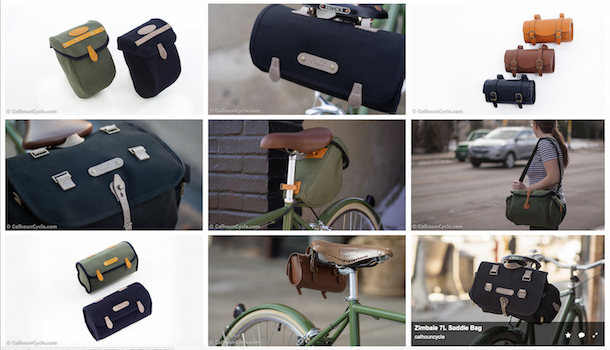
While Zimbale's classic designs using leather and cotton canvas have a similar aesthetic to our ever-beloved Carradice bike bags from England, each brand has it's own unique identity and offering choices in bike bags is important at Perennial Cycle. We know that some people will be drawn to each company's products. Some because of the variation in each brand's look and others for each brand's specific designs. For example, a camera buff may prefer the boxier shape of the Zimbale bags while a weekend tourer might prefer organizing his or her goodies in the more tubular Carradice bag.

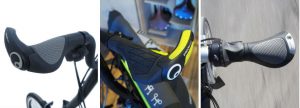

















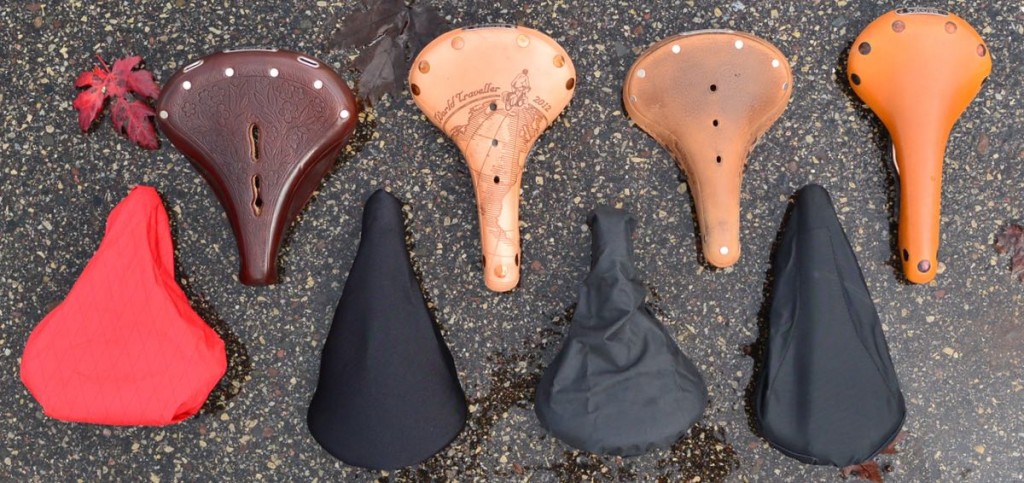

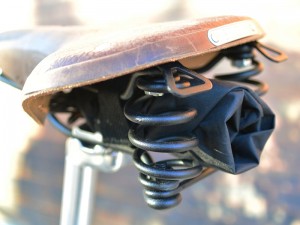
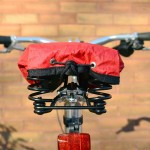
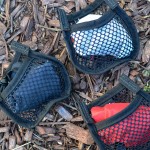

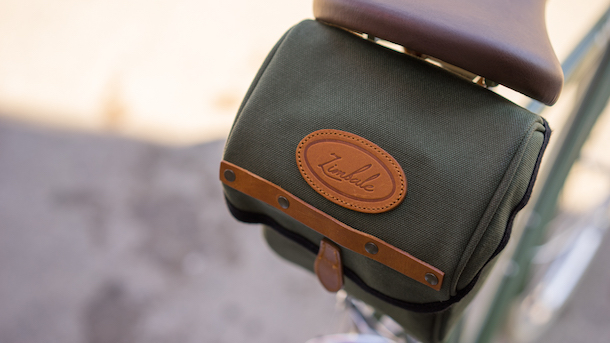


Validate your login
Sign In
Create New Account